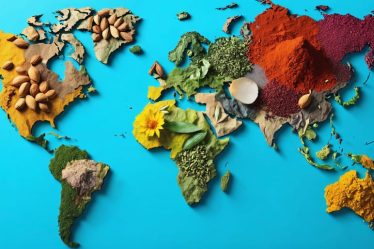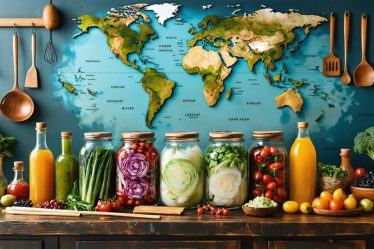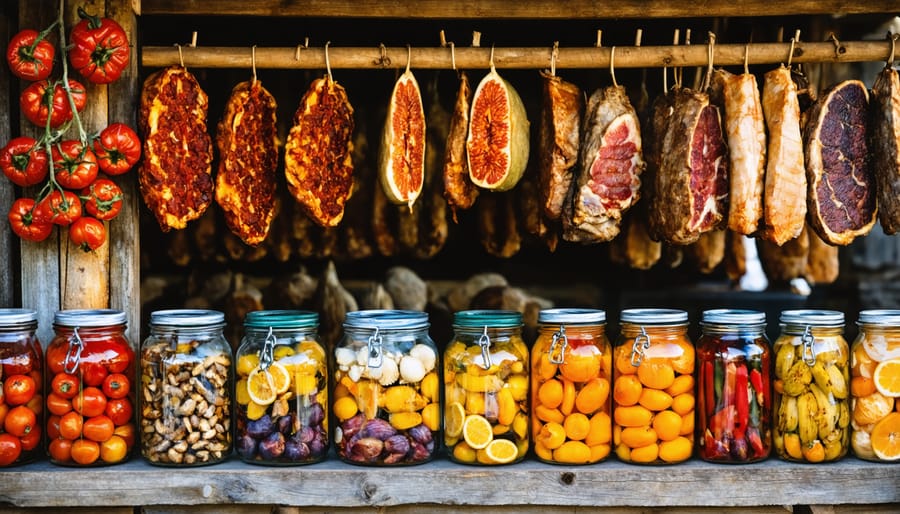
Long before modern refrigeration, our ancestors mastered ingenious traditional food preservation methods that still hold profound relevance today. From the sun-dried tomatoes of Mediterranean villages to the fermented kimchi of Korean households, these time-tested techniques didn’t just keep food edible – they created entirely new flavors and enhanced nutritional profiles.
What’s truly fascinating is how these ancient preservation practices transcended mere survival needs to become cornerstone traditions that shaped cuisines worldwide. Picture smoke rising from Nordic fish-smoking huts, or imagine the careful process of burying Arctic meats in permafrost – each method tells a story of human ingenuity and deep connection to the natural world.
Today, as we seek more sustainable and authentic ways to connect with our food, these ancestral techniques offer more than just practical solutions. They provide a bridge to our cultural heritage and a path toward more mindful, sustainable food practices. Whether you’re a curious home cook or a dedicated food enthusiast, understanding these time-honored preservation methods opens up a world of culinary possibilities that our ancestors knew all too well.
Salt: The Ancient World’s Food Preservation Superstar
Dry Salting Methods
You know, there’s something almost magical about the way our ancestors used simple salt to preserve their precious food. I remember my grandmother telling me stories about her mother’s dry salting techniques, and it’s amazing how these methods have stood the test of time.
The basic process of dry salting involves covering meat or fish completely with salt, drawing out moisture to create an environment where harmful bacteria simply can’t survive. Picture this: layers of salt embracing fresh cuts of meat or fish, working their preservation magic day after day.
For meat preservation, our ancestors would first cut the meat into manageable pieces, then thoroughly rub them with salt, making sure to cover every nook and cranny. They’d place these salted cuts in a cool, dry place, often layering more salt between pieces. The meat would gradually release its moisture, and after about two weeks, it would be ready for long-term storage.
Fish preservation followed a similar pattern, though usually with a shorter timeline. After cleaning the fish, they’d pack it in salt for several days to a week, depending on its size. Some cultures would even alternate layers of fish and salt in special wooden barrels – a technique still used in some traditional communities today.
What’s particularly fascinating is how different cultures adapted this method to their specific needs and climates. Mediterranean communities, for instance, often combined dry salting with sun-drying to create intensely flavored preserved fish that we still enjoy today.
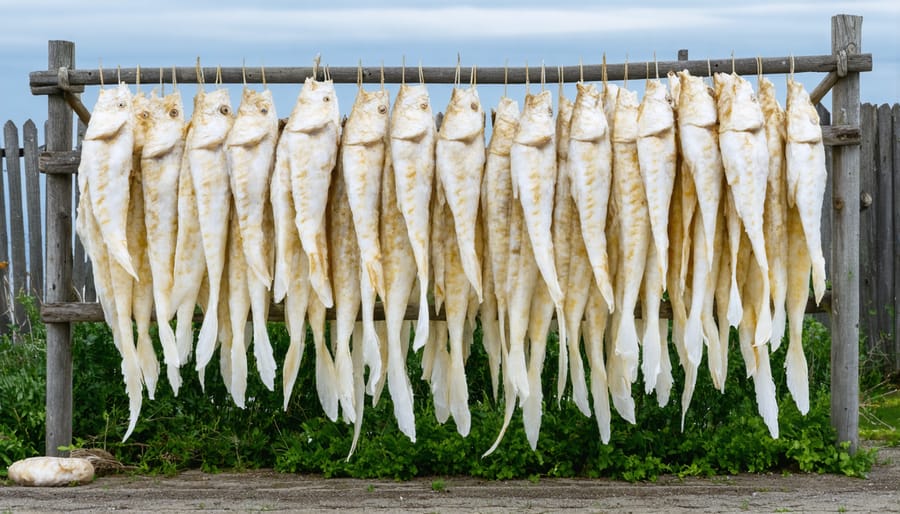
Brining and Pickling
I’ve always been fascinated by how our ancestors discovered that salt could transform everyday foods into long-lasting treasures. Brining and pickling were among the most versatile preservation methods, practiced across countless cultures with their own unique twists.
In ancient China, vegetables were preserved in salt water, creating what we now know as traditional Chinese pickles. These weren’t just practical – they became integral to Chinese cuisine, adding that perfect tangy kick to meals. Meanwhile, in Northern Europe, communities developed their own brining techniques for preserving fish and meat, with Baltic herring being a prime example of this craft.
The ancient Romans had a particularly interesting approach – they created a fish sauce called garum through a careful process of layering fish with salt and letting it ferment. While it might sound unusual to our modern palates, this was their equivalent of today’s beloved condiments!
In the Mediterranean, olives were (and still are) transformed from bitter fruits into delicious treats through an intricate brining process. This technique has remained largely unchanged for thousands of years – a testament to its effectiveness.
What I find most remarkable is how these methods weren’t just about preservation – they were about transformation. The fermentation that naturally occurred during brining added new flavors and even beneficial probiotics, making these foods not just longer-lasting but often more nutritious than their fresh counterparts.
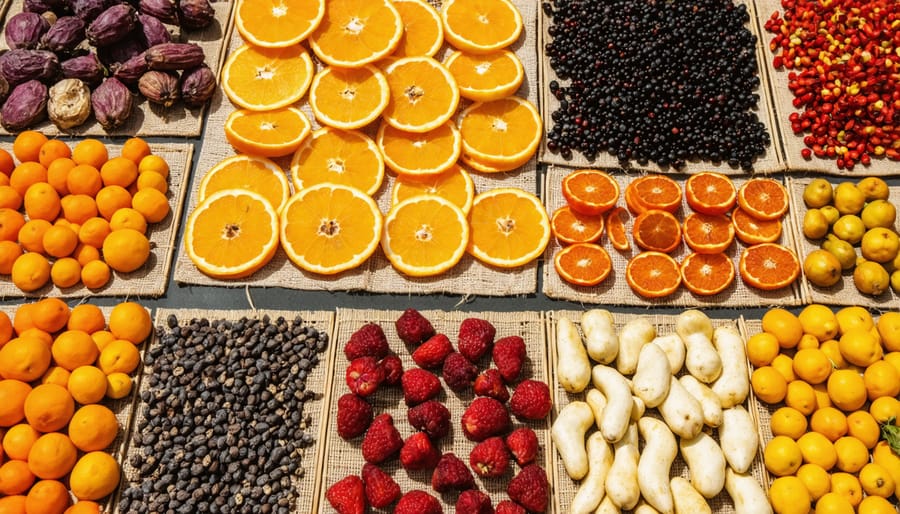
Sun-Powered Preservation
Sun-Dried Delicacies
I can still vividly remember my grandmother laying out bright red tomatoes on woven bamboo mats in her sun-drenched backyard, a practice that connects us to countless generations of food preservers across the globe. Sun-drying has been one of humanity’s most cherished ways of preserving food, deeply woven into our cultural food traditions.
In Mediterranean regions, you’ll find sun-dried tomatoes and figs decorating rustic wooden racks, while in Japan, persimmons are transformed into the sweet, wrinkled delicacy known as hoshigaki. The vibrant streets of Morocco showcase dates and apricots drying in the desert sun, their sugars concentrating to create nature’s candy.
Native American communities traditionally dried buffalo meat into pemmican, while in the Andes, people still create chuño by leaving potatoes out to freeze at night and dry during the day. In parts of Asia, fish and shrimp are dried on large bamboo sheets, creating intensely flavored ingredients that become the backbone of many traditional dishes.
What makes sun-drying so special is its beautiful simplicity – just pure sunshine and time, transforming everyday ingredients into concentrated bursts of flavor that can last for months or even years.
Traditional Drying Techniques
Have you ever noticed how your grandmother’s sun-dried tomatoes taste incomparably better than store-bought ones? That’s because traditional drying techniques, passed down through generations, have been perfected over thousands of years to preserve food’s natural flavors and nutrients.
Our ancestors were incredibly resourceful when it came to drying foods. They would carefully select the perfect spots – typically flat surfaces elevated from the ground – where foods could catch maximum sunlight while staying protected from dust and insects. Wooden racks, woven mats, and even specially designed drying houses were common tools of the trade.
I remember visiting a small village in Italy where families still dry their tomatoes and herbs on wooden frames laid across their sun-drenched terraces. The process is beautifully simple: fruits, vegetables, herbs, and even meats are thinly sliced and arranged in single layers to ensure even drying. Some cultures add salt or other natural preservatives to speed up the process and enhance preservation.
The key to successful sun-drying lies in timing and weather conditions. Warm, dry days with good air circulation are ideal, and most foods need 3-7 days of consistent sunlight to dry properly. Our ancestors would often cover their drying foods with lightweight cloth to protect them from insects while still allowing airflow.
Fermentation: Nature’s Preservation Magic
Vegetable Fermentation
I remember my grandmother’s root cellar filled with jars of vibrant pickled vegetables, a tradition that connected us to countless generations before. Vegetable fermentation isn’t just a preservation method; it’s a beautiful dance between nature and necessity that our ancestors mastered centuries ago.
At its heart, fermentation relies on beneficial bacteria naturally present on vegetables to transform them into tangy, probiotic-rich preserves. When I first explored these fermentation techniques, I was amazed by their beautiful simplicity – just vegetables, salt, and time.
The process typically begins by submerging cleaned vegetables in a salt brine, creating an environment where good bacteria thrive while harmful ones can’t survive. Common examples include Korean kimchi, German sauerkraut, and Indian pickled mango. Each culture has developed its own unique combinations of vegetables and spices, reflecting local ingredients and tastes.
What makes this method particularly special is that it not only preserves food but actually enhances its nutritional value. The fermentation process creates beneficial enzymes, B-vitamins, and various strains of probiotics. Plus, the finished products have this wonderful complex flavor that you just can’t replicate with modern preservation methods.
For those of us looking to connect with our roots while creating something delicious and healthy, vegetable fermentation offers a perfect blend of tradition and practicality.
Dairy Fermentation
Have you ever wondered how our ancestors kept dairy products fresh without refrigeration? It’s fascinating how they developed ingenious methods to preserve milk, turning it into products that could last for months or even years. I remember my grandmother telling stories about her mother making yogurt in earthen pots, a tradition that connected generations through food preservation.
The art of dairy fermentation dates back thousands of years, with different cultures developing their unique preservation techniques. The most common method was turning milk into yogurt, which not only extended its shelf life but also created a nutritious and versatile food product. Our ancestors discovered that leaving milk in warm conditions with specific bacterial cultures would transform it into thick, tangy yogurt.
Cheese-making was another brilliant preservation breakthrough. By using rennet (an enzyme found in animal stomachs) or natural acidic substances, people learned to separate milk into curds and whey. The curds could then be pressed, aged, and transformed into various types of cheese that would keep for extended periods.
In many nomadic societies, fermented milk drinks like kefir became staples. These communities found that specific grain-like cultures could transform milk into a fizzy, probiotic-rich beverage that remained safe to drink for weeks. Even butter was preserved through a process of clarification, creating ghee, which could last for months without refrigeration.
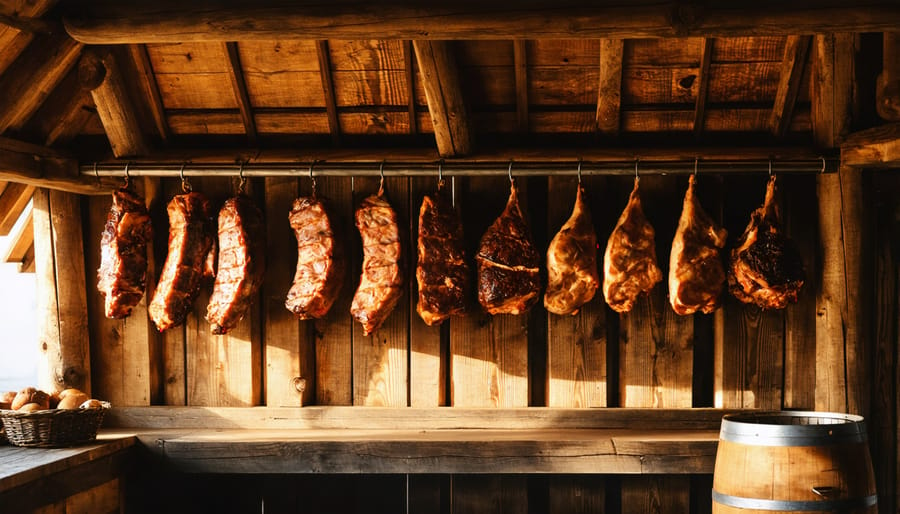
Smoking and Curing
Cold Smoking Traditions
I remember my grandmother telling stories about how her family would preserve meat during harsh winters, using techniques passed down through generations. Cold smoking, one of humanity’s oldest preservation methods, was truly an art form that brought communities together while ensuring survival.
Unlike hot smoking, which cooks the food, cold smoking was performed at temperatures below 90°F (32°C), often over several days or even weeks. Our ancestors would carefully hang meat or fish in specially designed smokehouses, where gentle wisps of smoke from hardwoods like oak, apple, or hickory would slowly infuse the food with preservative compounds while developing complex flavors.
Different cultures developed their own unique approaches to cold smoking. In Scandinavia, gravlax (salmon) was cold-smoked using juniper wood, while Eastern European communities became famous for their smoked sausages and hams. Native American tribes often used smoking techniques to preserve buffalo meat, creating what we now know as pemmican.
The process wasn’t just about preservation – it was a social activity that brought families together. Smoking houses became gathering places where stories were shared and traditions passed down. Even today, in some remote villages across Europe and Asia, you can still find communities practicing these ancient smoking methods, maintaining a connection to their cultural heritage while producing incredibly flavorful preserved foods.
Hot Smoking Methods
Picture gathering around a crackling fire with our ancestors as they perfected the art of hot smoking – a preservation method that’s as much about flavor as it is about keeping food lasting longer. I’m always amazed by how this ancient technique has stood the test of time, still bringing warmth and delicious aromas to our modern kitchens.
Traditional hot smoking involved suspending meat or fish above a fire, typically in a specially constructed smokehouse or enclosure. The food would be placed high enough to avoid direct heat while allowing the warm smoke to gently cook and preserve it. Our ancestors discovered that certain woods, like oak, hickory, and apple, not only helped preserve the food but also imparted distinctive, mouthwatering flavors.
The process usually began with a salt cure to draw out moisture, followed by smoking at temperatures between 150°F and 250°F. This combination of heat and smoke created an environment hostile to bacteria while slowly cooking the food. What I find fascinating is how different cultures developed their own unique variations – from the Native American tradition of smoking salmon on cedar planks to the European practice of smoking hams in stone smokehouses.
The beauty of hot smoking lies in its dual purpose: it not only preserved food for months but also created deeply flavorful dishes that became cherished cultural traditions. Many of these smoking techniques have been passed down through generations, and you can still find them being used in traditional foodways today.
As we reflect on these time-tested methods of food preservation, it’s remarkable how our ancestors’ wisdom continues to resonate in our modern kitchens. These traditional techniques weren’t just about survival; they were about understanding and working in harmony with nature’s rhythms. Today, as we embrace mindful food preparation, these ancient practices offer us valuable lessons in sustainability and self-sufficiency.
I’m constantly amazed by how many of my readers have shared stories of rediscovering their grandmother’s pickling recipes or learning traditional fermenting techniques from their local community. These methods aren’t just preserving food; they’re preserving cultural heritage and family connections.
In our world of instant gratification and processed convenience foods, these time-honored preservation techniques remind us of the importance of patience and planning. They teach us to appreciate seasonal abundance and prepare thoughtfully for leaner times. More importantly, they show us that sometimes the old ways are the best ways – natural, chemical-free, and surprisingly effective.
Whether you’re interested in reducing food waste, eating more sustainably, or simply connecting with traditional foodways, these ancient preservation methods have something valuable to offer. They remind us that good food doesn’t need complex technology or artificial preservatives to last. As we face modern challenges around food security and environmental sustainability, these time-tested techniques might just hold some of the answers we’re looking for.
Let’s carry these ancient wisdom threads forward, weaving them into our modern lives in ways that make sense for our families and our planet.

